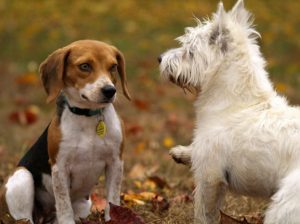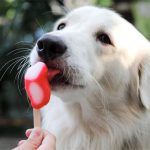The Canine Heat Cycle.
All female dogs that have not been spayed, will come into ‘heat’, usually twice per year. This is also known as a season, or oestrus and is the equivalent of human menstruation. This Holidays4Dogs article provides information on the canine heat cycle – what to expect and what to consider while your girl is in-season.
Female dogs will generally have their first season from about the age of six months, but this can vary. Some dogs will not have their first season until nearly a year old.
Signs a female dog is coming into season.
Initial signs of a season can be difficult to spot, especially with the first season.  However, owners may notice the female dog’s vulva becoming swollen, with signs of discharge. The discharge will be a bright red colour. As the canine heat cycle progresses, this becomes more watery and clear.
However, owners may notice the female dog’s vulva becoming swollen, with signs of discharge. The discharge will be a bright red colour. As the canine heat cycle progresses, this becomes more watery and clear.
How long do seasons last?
Once the canine heat cycle begins, it can last for around three weeks on average. However, anything from two, to four weeks in season, would also be considered normal.
It is possible for your dog to become pregnant at any point in her season. However, she will be at her most fertile from around day ten, to day fifteen.
What to expect during your dog’s season.
The behaviour of the female dog in season may change. Changes in behaviour may involve restlessness, for example, or even attempts to mount other dogs – yes, female dogs do this too.
It is quite common for female dogs in season to urinate more frequently too. Female dogs will do this to let males know of their whereabouts.
Make sure she can relieve herself frequently. Refrain from scolding her if she does soil the house, as this is only a natural and temporary response.
How to manage the canine heat cycle.
When she is at the most fertile stage, you will notice that she will ‘stand’ for other dogs. In other words, she will present herself to the dog and sweep her tail to one side, inviting him to mate her. A female dog can be quite desperate to escape during these crucial few days.
Keeping your girl away from other dogs when she is in season can challenging. Entire dogs can locate in-season females from a long way away, even if she is in the home, or garden. It isn’t unheard of for local canine Casanovas to form a less than orderly queue outside the home of female dog in heat! When out walking, it may be a good idea to keep her on the lead at this stage in her heat cycle.
Equally, it is important to make sure she cannot escape from the garden. If you know there are local male dogs in the neighbourhood – avoid leaving her unattended in the garden, as she could become quite frantic about escaping.
Can I walk my dog while she is in season?
You can still walk your dog while she is in season. However, it may be a little trickier because she is bound to receive more attention than usual from other dogs. If you take an in-season female for a walk – where there are usually lots of other dog walkers with their pets – be aware that you may not be very popular!
Keeping to streets and footpaths will
mean you are unlikely to meet other dog walkers who have their dog off the lead. Going to parks, or open countryside, is likely to attract off-lead dogs to your girl.
This can create problems for other owners, as it will be more difficult for them to get their dog back under such temptation.
Head for places where you would least expect other dogs to be off-lead. You can try an anti-season spray, which may help to mask the female’s scent from other dogs. People report having varying amounts of success with this during the canine heat cycle.
Conclusion.
If you do not intend to breed from your dog, spaying is the only option to prevent future canine heat cycles. Female dogs do not need to have puppies before being spayed. However, it is best to discuss this with your vet since neutering can have adverse effects on individual dogs, as well as benefits.



